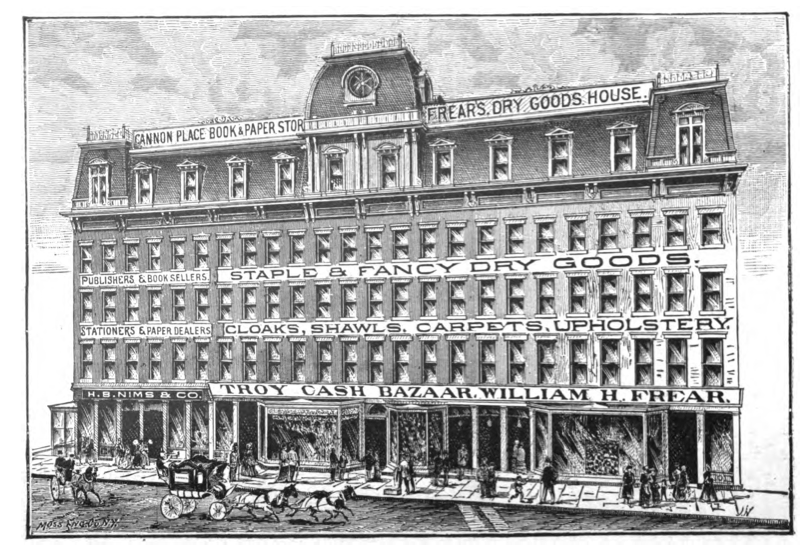
William H. Frear, at Cannon Place, has the personal distinction of possessing and conducting a larger retail dry-goods business than any merchant in a city of the United States of the same population as that of Troy. The patronage of “Frear’s Troy Bazaar” is not wholly local, for its fame attracts customers from all the cities, villages and rural districts of Eastern and Northern New York, Vermont, and Western Massachusetts.
The people daily thronging the spacious salesrooms of the well-regulated establishment are not the only evidence of the magnitude of its business. More than twelve thousand letters and packages are received and transmitted monthly through the post-office. Four, and sometimes eight, wagons are engaged in delivering goods to purchasers in the city and its vicinity. From two hundred and fifty to three hundred persons are employed in the different departments of the large store. The annual cash sales of the retail departments exceed $1,000,000.
The main salesroom, on the first floor, has a frontage of 100 feet on Washington Square, and a depth of 119 feet. The part extending to the Second Street entrances has a width of 44 feet and a depth of 130 feet. On the second floor are the cloak, shawl and suit departments, the upholstery department, and the kitchen furnishing department. On the Second Street third floor is the counting room. In the basement are the goods-receiving, the carpet, and the wholesale departments.
In February, 1859, William H. Frear came to Troy, and, on March 1, entered as a salesman the dry-goods store of John Flagg, at No. 12 Fulton Street. On February 11, 1865, he and Sylvanus Haverly formed the partnership of Haverly & Frear. On March 9, that year, they opened a dry-goods store at No. 322 River Street. By articles of agreement drawn on January 29, 1868, John Flagg became a copartner on March 16, 1868; the firm taking the name of Flagg, Haverly, & Frear. On April 9, that year, the firm occupied the store-rooms Nos. 3 and 4 Cannon Place, vacated by Decker & Rice. On January 2, 1869, Sylvanus Haverly withdrew, and the firm-name was changed to that of Flagg & Frear. On the expiration of the partnership of Flagg & Frear, on March 1, 1874, William H. Frear came into possession of the business. In 1875, ’76, ’80, and ’84, he enlarged the establishment by renting and refitting adjoining rooms, so that at present he occupies Nos. 3, 4, 5, 6, 7, and 8 Cannon Place, and Nos. 13 and 15 Second Street.
“The City of Troy and Its Vicinity,” Arthur James Weise, 1886.
Of course, Frear’s later moved from the still-standing Cannon Building up to Third and Fulton, where its palatial home with the magnificent iron staircase still stands.
